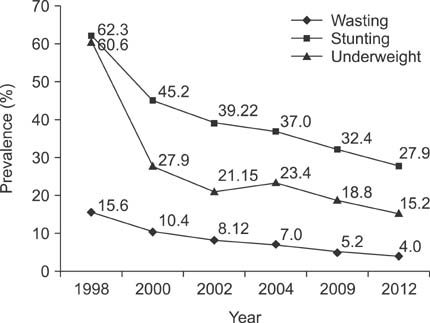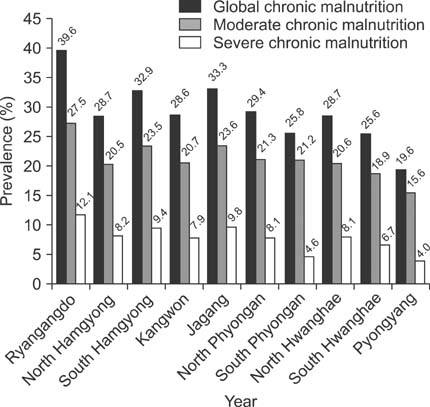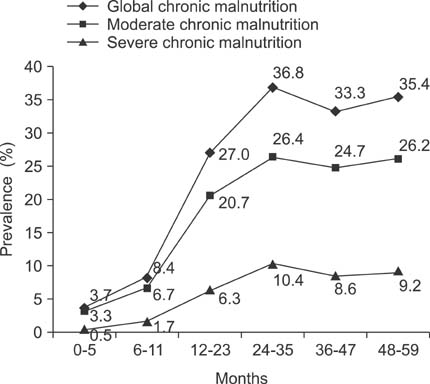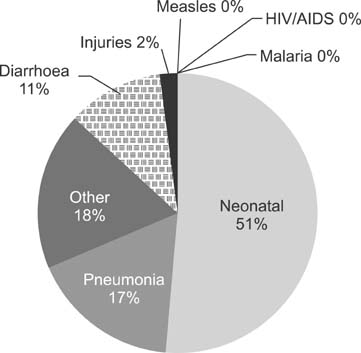Pediatr Gastroenterol Hepatol Nutr.
2014 Sep;17(3):135-139. 10.5223/pghn.2014.17.3.135.
Nutritional State of Children in the Democratic People's Republic of Korea (DPRK): Based on the DPRK Final Report of the National Nutrition Survey 2012
- Affiliations
-
- 1Department of Pediatrics, Shincheon Union Hospital, Siheung, Korea. galmuae1@naver.com
- KMID: 1803112
- DOI: http://doi.org/10.5223/pghn.2014.17.3.135
Abstract
- A nationwide nutrition survey began when the Democratic People's Republic of Korea (DPRK) requested assistance from international relief organizations in 1997 due to flooding in 1995-1996, followed by the worsening food shortage peak in 1997. According to reported data for the 15 years since the active intervention and assistance from international societies, the malnutrition and mortality rates of children in the DPRK have improved. However, the prevalence of the stunting reported in the latest 2012 report is 27.9%, which is still a moderate-severe level, and worrisome in terms of international standards. In particular, the prevalence in Ryangangdo, which is regarded as the worst region in the DPRK, is 39.6%, which is a very high level of stunting. To alleviate such regional deviation will be a major task for future assistance. In addition, one cannot emphasize too highly the importance of early nutritional assistance for pregnant women and infants, considering that the recovery from stunted growth is low after two years of age, and the aftereffects would continue for the rest of their lives.
MeSH Terms
Figure
Cited by 3 articles
-
Effect of nutritional supplement formula on catch-up growth in young children with nonorganic faltering growth: a prospective multicenter study
Jung Ok Shim, Seung Kim, Byung-Ho Choe, Ji-Hyun Seo, Hye Ran Yang
Nutr Res Pract. 2020;14(3):230-241. doi: 10.4162/nrp.2020.14.3.230.Characteristics and Distribution of Surgical Diseases in North Korean Research Papers Published between 2006 and 2017
Yo Han Lee, Namkee Oh, Hyerim Kim, Shin Ha
J Korean Med Sci. 2021;36(12):e25. doi: 10.3346/jkms.2021.36.e25.North Korean children: nutrition and growth
Soo-Kyung Lee
Ann Pediatr Endocrinol Metab. 2017;22(4):231-239. doi: 10.6065/apem.2017.22.4.231.
Reference
-
1. UNICEF. Democratic People's Republic of Korea final report of the National Nutrition Survey 2012. Pyongyang: UNICEF;2012. cited 2013 Mar. Available from: http://www.unicef.org/eapro/DPRK_National_Nutrition_Survey_2012.pdf.2. UNICEF Pyongyang. Report on the Multiple Indicator Cluster Survey in the DPRK. Pyongyang: UNICEF;1998.3. EU. UNICEF. WFP. Nutrition Survey of the DPRK. Pyongyang: UNICEF;1998. cited 1998 Nov. Available from: http://www.pwdigby.co.uk/pdf/Report_on_the_DPRK_Nutrition_Assessment_1998.pdf.4. DPRK Central Bureau of Statistics. Report of the Second Multiple Indicator Cluster Survey 2000, DPRK. Pyongyang: DPRK Central Bureau of Statistics;2000. cited 2000 Oct. Available from: http://www.childinfo.org/files/dprk.pdf.5. DPRK Central Bureau of Statistics. Report of the DPRK Nutrition Assessment. Pyongyang: UNICEF;2002. cited 2003 Feb. Available from: http://www.unicef.org/dprk/nutrition_assessment.pdf.6. DPRK Central Bureau of Statistics. DPRK 2004 Nutrition Assessment Report of Survey Results. Pyongyang: DPRK Central Bureau of Statistics, Institute of Child Nutrition;2004. cited 2005 Feb. Available from: http://www.unicef.org/dprk/dprk_national_nutrition_assessment_2004_final_report_07_03_05.pdf.7. UNICEF CBS. DPRK Multiple Indicator Cluster Survey 2009. Pyongyang: DPRK Central Bureau of Statistics;2009. cited 2010 Dec. Available from: http://planipolis.iiep.unesco.org/upload/Korea%20DPR/Korea_DPR_MICS_2009.pdf.8. UNICEF. DPRK at a glance 2013 (Feb). Pyongyang: UNICEF;2013. cited 2013 Feb. Available from: http://www.unicef.org/dprk/DPRK_at_a_glance_April_2013.pdf.
- Full Text Links
- Actions
-
Cited
- CITED
-
- Close
- Share
- Similar articles
-
- Status of Maternal Nutrition in South and North Korea
- Status of Plasmodium vivax Malaria in the Republic of Korea after Reemergence
- The Role of Major Donors in Health Aid to the Democratic People's Republic of Korea
- Status of Early Childhood and Maternal Nutrition in South Korea and North Korea
- Sustaining peace on the Korean Peninsula and the role of international organizations: a secondary publication






